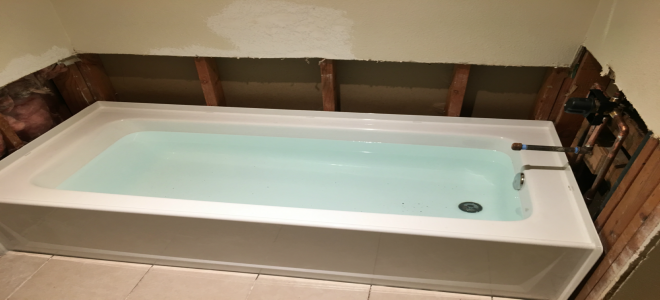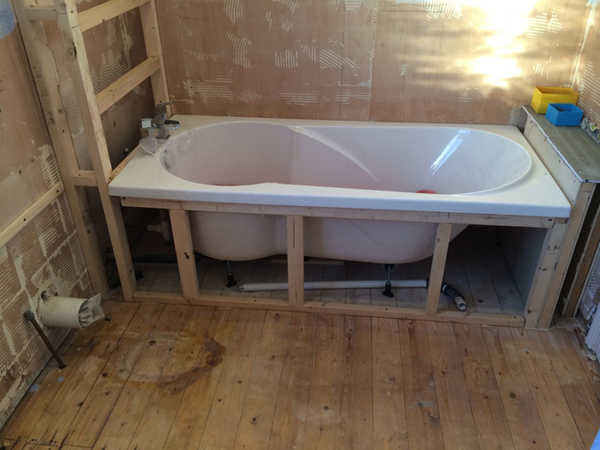Exploring Plumbing Fundamentals for Installing a Bathtub
Exploring Plumbing Fundamentals for Installing a Bathtub
Blog Article
What are your ideas concerning Installing A Bathtub?

Setting up a bath tub isn't specifically rocket science, but it does need strong plumbing, woodworking, and also sometimes, tiling skills. Replacing an old tub with a brand-new one is likewise a reasonably tough project. If the old tub is readily available, the job can move rapidly; if you need to open a wall to remove the old bathtub and also position the brand-new bath tub, the job is much harder. In either case, the job is within a house handyman's skills, although you will certainly require a helper to leave the old tub and also embeded in the new one. Make sure you have actually qualified on your own for the task and fit attempting it. Instead of hiring a contractor to take control of a halfway-completed task, it is far better to consider employing one before you start. Possibilities are you might require a specialist plumber to make tube links.
This short article will certainly help you install a new tub in your washroom if you have actually currently acquired a brand-new tub and don't require to alter the plan of your previous supply of water pipes.
Your devices as well as product checklist should comprise the following:
Removing Old Touches
If you need to change old faucets with new ones as a part of your setup, then the first thing you need to do is disconnect the water supply. After doing so, activate the taps to drain pipes any kind of water staying in the system. The procedure of eliminating the existing faucets can be rather problematic as a result of the limited access that is often the situation.
Use a basin wrench (crowsfoot spanner) or a faucet device to undo the nut that connects the supply pipelines to the taps. Have a cloth all set for the staying water that will come from the pipelines. Once the supply pipelines have been gotten rid of, utilize the very same device to loosen the nut that holds the faucets onto the bath/basin. You will certainly need to quit the solitary taps from turning throughout this process. When the taps have been gotten rid of, the holes in the bath/basin will have to be cleansed of any old sealing substance.
Prior to proceeding to fit the brand-new faucets, compare the pipe links on the old taps to the new faucets. If the old faucets are longer than the brand-new faucets, then a shank adapter is required for the new taps to fit.
Suitable New Touches
If the tails of the brand-new taps are plastic, then you will need a plastic port to avoid damages to the string. One end of the adapter fits on the plastic tail of the faucet and also the various other end supplies a connection to the existent supply pipes.
If you need to fit a monobloc, then you will require minimizing couplers, which links the 10mm pipe of the monobloc to the common 15mm supply pipeline.
Next off, position the tap in the mounting opening in the bath/basin making sure that the washers are in area in between the tap and also the sink. Safeguard the faucet in position with the manufacturer given backnut. As soon as the faucet is safely in place, the supply pipelines can be linked to the tails of the faucets. The taps can either be connected by utilizing corrugated copper piping or with normal faucet connectors. The previous type needs to be linked to the tap finishes first, tightening up just by hand. The supply pipes can later on be connected to the various other end. Tighten up both ends with a spanner after both ends have been linked.
Setting up the Bath tub
Using both wood boards under its feet, place the bathtub in the needed placement. The wooden boards are practical in evenly spreading the weight of the tub over the location of the boards as opposed to focusing all the weight onto four little points.
The following objective is to make certain that the bathtub is leveled all round. This can be accomplished by inspecting the level as well as changing the feet on the tub till the level reviews degree.
To mount faucets, fit the bottom of the outermost adaptable faucet adapter to the proper supply pipeline by making a compression join; then do the same for the various other faucet.
Turn on the water system and also inspect all joints and brand-new pipework for leakages as well as tighten them if required. Fill the bath tub and also check the overflow electrical outlet as well as the normal outlet for leaks.
Finally, fix the bath paneling as explained in the supplier's instruction manual. Tiling as well as sealing around the bath tub must wait until the tub has actually been used at the very least once as this will settle it right into its last setting.
Getting ready for the Installation
Firstly, the supporting framework supplied with the bath ought to be fitted (if needed) according to the supplier's instructions. Next, fit the taps or mixer to the bathtub. When suitable the tap block, it is necessary to see to it that if the faucet features a plastic washing machine, it is fitted between the bath as well as the taps. On a plastic bath, it is likewise reasonable to fit a supporting plate under the faucets device to stop pressure on the bath tub.
Fit the versatile tap connectors to the bottom of the two taps making use of 2 nuts and also olives (in some cases supplied with the bathtub). Fit the plug-hole electrical outlet by smearing mastic filler round the sink electrical outlet hole, and then pass the electrical outlet via the hole in the bathroom. Use the nut supplied by the maker to fit the plug-hole. Take a look at the plug-hole outlet for an inlet on the side for the overflow pipeline.
Next off, fit the end of the versatile overflow pipe to the overflow electrical outlet. After that, screw the pipeline to the overflow face which must be fitted inside the bath. See to it you utilize all of the supplied washing machines.
Connect the catch to the bottom of the waste outlet on the bath tub by winding the string of the waste outlet with silicone mastic or PTFE tape, as well as screw on the trap to the outlet. Link the bottom of the overflow tube in a comparable manner.The bathroom need to now prepare to be suited its last position.
Tiling Around the Bathtub
In the location where the bathroom meets the ceramic tile, it is required to seal the accompanies a silicone rubber caulking. This is essential as the installation can move sufficient to break a rigid seal, triggering the water to penetrate the wall between the bathroom and the tiling, causing issues with dampness as well as feasible leaks to the ceiling below.
You can choose from a selection of coloured sealers to blend in your fixtures and also fittings. They are sold in tubes and cartridges, and can securing voids as much as a width of 3mm (1/8 inch). If you have a larger gap to fill, you can load it with spins of soaked paper or soft rope. Bear in mind to constantly fill up the bathtub with water prior to securing, to allow for the activity experienced when the tub remains in use. The sealer can split relatively very early if you do not consider this activity prior to sealing.
Alternatively, ceramic coving or quadrant tiles can be utilized to edge the bath or shower tray. Plastic strips of coving, which are easy to use and reduce to size, are additionally easily offered on the market. It is suggested to fit the tiles making use of waterproof or water resistant glue and also grout.
Bathtub Installation
How Important Is A Bathtub To Your Home?
High-quality baths, showers, and other bathroom updates are necessary when considering a smart investment in your home. It’s a room that you go to every day and one that is constantly being used by guests.The bathroom is one of the top trafficked rooms in a home and also one of the most valuable in terms of home resale.
Install Piping Before Tub
You will be using your existing drain and waste vent system, but pipes required include the hot and cold water supply lines and a pipe leading to a shower head. A mixing valve and shower head are also needed. Air chambers may be required.
Position the Tub
Lower the tub into place so that the continuous flange fits against the wall studs and rests on 1’x4' or 2’x4' supports. Anchor the tub to the enclosure with nails or screws inserted through the flanges into the studs.
NOTE: Remember, bathtubs and shower stalls may require support framing. A bathtub filled with water is extremely heavy, so check building codes and framing support before installing the tub.
Assemble Drain Connections
Assemble the bathtub drain connections by connecting the tub overflow with the tub drain above the trap, not beyond it. The trap will have a compression fitting that screws over the arm of the overflow assembly.
Place a Pipe For the Shower Head
First, locate a brass female threaded winged fitting and attach it to a framing support via a screw or a nail. Then run a pipe up the wall for the shower head. Sweat or solder the other side of the brass fitting to the top of the pipe.
Attaching Hot and Cold Water Lines
Attach your water lines for both hot and cold by sweating these directly into the hot and cold ports of the mixing valve. The mixing valve will be how water enters the tub’s system, not by the pipes themselves.
Install the Spout
Extend a piece of 1/2 inch pipe, or whichever length is specified in the manufacturer’s instructions, for the tub spout. Sweat on a male threaded fitting at the end of the pipe or use a brass nipple of the proper length and a 1/2 inch cap.
NOTE: At this point you should have your rough-in plumbing work inspected before proceeding further.
Check For Leaks
Restore the water pressure and check the drain connection and the supply pipes for any sign of leaking.
estore the Bathroom Wall
Replace the wall with moisture-resistant drywall as a base for your wall covering. Seal the joints between the wall and your new tub with silicone caulk as protection against water seepage.
https://www.berkeys.com/2016/12/02/bathtub-installation-dallas/

Do you enjoy more info about Installing A Bathtub? Create a remark below. We will be delighted to hear your thinking about this blog entry. Hoping to see you back again later on. If you enjoyed reading our blog entry if you please do not forget to pass it around. Thanks for going through it.
Secure efficient service. Report this page